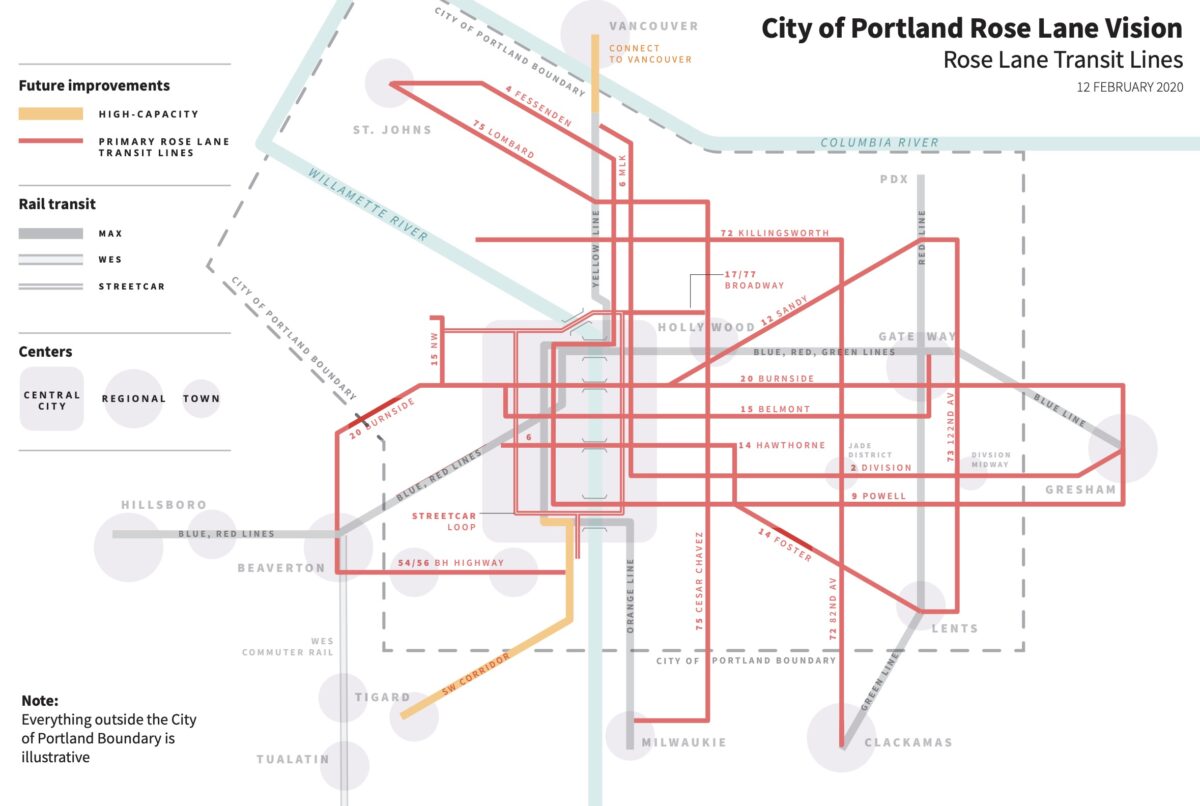
With existing plans as a foundation, buoyed by success of three initial projects, and — most importantly — with the full support of City Commissioner Chloe Eudaly and her staff, Portland City Council voted unanimously on Thursday to endorse the Rose Lane Project.
“We are now trying to correct that over-dedication of resources and space and priority to drivers. And I know it’s painful and unpopular with some people, but it has to happen.”
— Chloe Eudaly, city commissioner
Introducing her ordinance at the outset of the council meeting yesterday, Commissioner Eudaly summed up why she’s pushed so hard and so fast for this project: “Climate change is here, we are already experiencing its consequences, and it hits our most vulnerable community members hardest.”
To reach our adopted emissions and transportation goals, Eudaly said Portlanders must “dramatically reduce” reliance on internal combustion engines, make 250,000 fewer trips by car every day, and drive half as much as we do today.
With the vote, council has given the green light to a vision of corridors citywide where transit vehicles will have priority over other road users. In addition to adopting the Rose Lane Project vision, councilors have also dedicated $7 million in funding to immediately begin final design and construction of 29 projects and a second phase that could cost up to $10 million. Since most phase one projects were already in development or “lend themselves to quick build” (in the words of a PBOT project manager), they will be constructed this year.
In close partnership with TriMet, PBOT will deploy tools already endorsed by council via the Enhanced Transit Corridors plan passed in 2018. Using a mix of signal technology, dedicated lanes, and other methods, PBOT will aim to make Rose Lane lines more “fast, frequent, and full”. They promised council the projects would make 24% more jobs accessible within 45 minutes on transit to 25,000 more people.
Advertisement
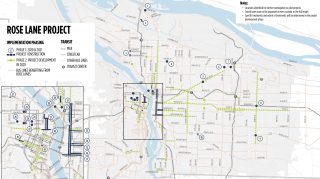
TriMet Executive Director of Public Affairs Bernie Bottomly said yesterday was a “seminal moment for the city” and likened it to PBOT and TriMet’s partnership on pioneering efforts like the downtown Transit Mall, light rail network and streetcar lines.
While TriMet is our regional transit provider, PBOT owns and manages city streets, so the two agencies have to dance together on big initiatives like this. Since TriMet has an unelected board of directors, a powerful employee union, and they aren’t a public agency, PBOT is forced to negotiate with them for help. They’ve agreed to add some service on Rose Lane lines (the effort dovetails with the boost in funding TriMet receives as part of the 2017 transportation package passed by the Oregon Legislature), but Eudaly acknowledged yesterday she was hoping for more.
Speaking to Bottomly, Eudaly said, “I do have to admit that I had hoped for a greater commitment to increase service to run simultaneously with the Rose Lanes. My concern is if we don’t meaningfully increase capacity on these lines that we won’t maximize their potential. We will have diminished outcomes in the pilot that may dampen the public’s enthusiasm and not get us to our ridership goals as soon as possible.”
Eudaly then asked Bottomly to be more nimble in making changes if/when Rose Lane projects significantly change ridership levels and she requested that TriMet invests any operational savings back into increased service on Rose Lane lines (she said TriMet currently spends $14 million a year due to congestion – UPDATE: Eudaly was referencing a June 2019 Willamette Week article that said TriMet spent $14 million over two years compensating for slow-moving traffic).
“If we can do more, we will,” Bottomly replied.
Advertisement
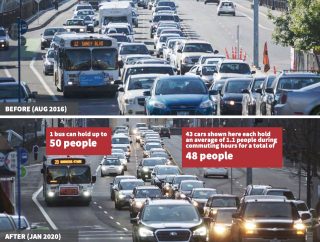
But that wasn’t the end of tough questions directed at the TriMet boss. Nervous laughter erupted in council chambers when Commissioner Amanda Fritz asked unexpectedly, “Would you state on the record that if we could find funding to make the entire system fare-free, would you be willing to do that?” After joking that he was out of time and had to go, Bottomly squeezed out a “Yes, but” and then explained that the $100 million annual farebox revenue isn’t the sum total of what it would cost and that a large increase in riders would lead to many other expenses for the agency.
“If it covers the real cost of the system, then yes,” Bottomly said. The exchange ended with Fritz saying, “Our planet is on fire, we need to take some bold moves.”
“Thank you. I’ve been grinning all day. I can’t believe this has happened so quickly. It’s incredible. This is going to be transformative. Please give it everything.”
— Alan Kessler, Portland resident during public testimony
30 people signed up to testify on the plans. The vast majority were strongly in favor. One man in opposition, Terry Parker, said, “Any plan that would reduce motor vehicle capacity must be accompanied by an environmental impact statement.” Another man who opposed it said councilors should work to make Portland more “car-friendly” or residents will move to other cities where driving is easier.
Attorney and activist Alan Kessler (yes that Alan Kessler) was ecstatic about the plans. But he implored council to get tougher on TriMet and do even more. “We need to tell TriMet, it’s not OK that you’re spending a billion dollars on a choo-choo train [SW Corridor light rail] that’s going to be here in a decade… What kind of transformation could we get with that kind of money?”
When it came time for closing remarks from commissioners, Eudaly took time to emphasize that transit-dependent Portlanders who don’t make much money and who are forced to live in parts of our city without a lot of transportation options are “at the heart” of this effort. She also took a wider view on what she pushed through today: “This city was not made for cyclists, pedestrians or bus riders. Unfortunately, it was made for auto drivers and we are now trying to correct that over-dedication of resources and space and priority to drivers. And I know it’s painful and unpopular with some people, but it has to happen.”
For many people, yesterday was a high point of Portland transportation history. “Thank you. I’ve been grinning all day,” testified Alan Kessler. “I can’t believe this has happened so quickly. It’s incredible. This is going to be transformative. Please give it everything.”
Learn more and stay plugged into Rose Lanes and the related Central City in Motion plans via this bulletin just released by PBOT.
— Jonathan Maus: (503) 706-8804, @jonathan_maus on Twitter and jonathan@bikeportland.org
— Get our headlines delivered to your inbox.
— Support this independent community media outlet with a one-time contribution or monthly subscription.


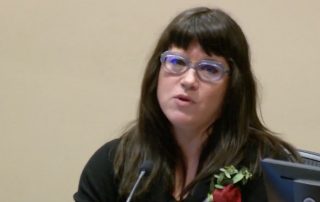
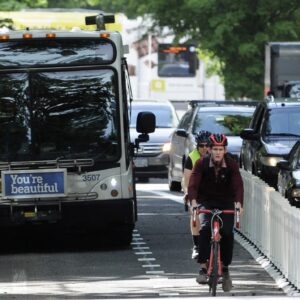
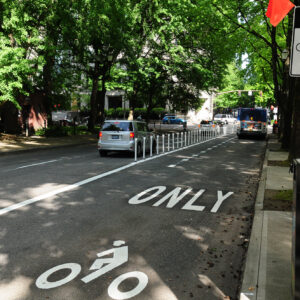
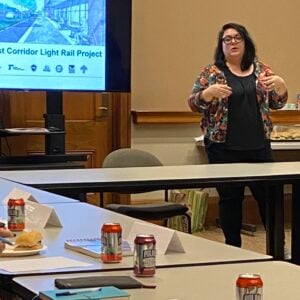
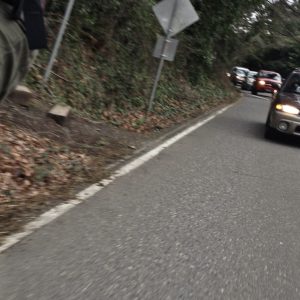
Thanks for reading.
BikePortland has served this community with independent community journalism since 2005. We rely on subscriptions from readers like you to survive. Your financial support is vital in keeping this valuable resource alive and well.
Please subscribe today to strengthen and expand our work.
Terry Parker and Randall O’Toole are cranks. They always and predictably say the same absurd thing, that private motor vehicles are under threat, disadvantaged.
As for better transit, and moving cars out of the way of it. YES!
I’m curious to see a link to the study that suggests Trimet ‘spends’ $14million on congestion. Seems like an important thing to understand better.
I’m looking for the source of that claim as well. Will update when I hear back from TriMEt.
Do try to source it, please, but my understanding is that’s the additional cost of driver labor and buses to add trips to be able to maintain the schedule when buses are stuck in congestion.
Found it (thanks TriMet). Eudaly was referring to this Willamette Week article where TriMet said they spent $14 million over two years to compensate for slow-moving traffic.
I wonder what the cost to society is to not have as many people riding bikes as we can because of inadequate infastructure.
Comment deleted and author put on moderation due to multiple personal insults and excessive meanness.
Jonathan. This “muttley” account is calling buses the “pain train” and going down the road of mocking climate activists. He has a repeat pattern of bad faith debate. It’s worse than a troll even. Is there any way to moderate and turn off this pattern?
One might say… let the transit haters have a second “reader comments’ forum if Word Press supported that. But my suggestion is delete them here.
Let them have their hate back channel on Twitter or 4chan or whatever the haters love. I’d go back to being a paid subscriber just to fund keeping off the people here who are only here to go off topic and derail. It’s clear that the Portland community of cyclists have very opposing views on endorsements or how to best get people walking, cycling and on transit ( and out of driving alone when possible. ) But outside of that agreement or disagreement we have the bias and obstruction of “muttley” and the like.
The thing that amazed me about yesterday was how NO ONE on council was at all worried about removing a few parking spaces or travel lanes. Doing big sweeping projects like this which cover the entire city is the way to go. Project by project does not work fast enough.
If there is a bicycle “Green Lane” project it has got to have a lot of equity initiatives. I think we are only scratching the surface of what is available right now. What about free electric cargo bikes (cheaper then our subsidy for electric cars), more bike valets so people do not have to worry about stolen bikes, adult bike safety programs (similar to safe routes to school but for grown ups), pay those jobs super well and give them to community groups. Give a bunch of money to Community Cycling Center and Bikes for Humanity.
Kiel, I know there’s some $600,000 total set aside for providing “safe secure bike parking” at Gateway, Green Line at Division and at Holgate, but neither PBOT nor TriMet have ever really defined what they mean by safe secure bike parking. Based on your operation at the tram stop, what would be your estimate of the annual subsidy needed to maintain an appropriate bike valet program at each of the three stops mentioned?
Actually Kiel, your statement is not correct. One council member begged for removal of more parking spots to make faster transit in low income areas a priority. The other 3 took no action to go after those parking spots and put those equity concerns into a revised plan. You see going after those parking spots would cost them votes.
Please email and ask for that mistake to be corrected: chole@portlandoregon.gov
Please Kiel, respond.
“Overdedication of resources”
A new phrase for me, but I like it.
Woohoo! Thank you and kudos to Commissioner Eudaly, PBOT staff and advocates who put a ton of work into this. This is an important step forward for the city. Let’s keep this momentum going!
“ Another man who opposed it said councilors should work to make Portland more “car-friendly” or residents will move to other cities where driving is easier.”
Ok, see ya!
Exactly. If you want to live in a city that prioritizes cars over people, you can basically pick any city in the US and move to it.
A great day for Portland. Now let’s get the bike plan built!
Near the beginning of the hearing it was mentioned that they’ll be bringing the frequency on the eastside streetcar up to ever 12 minutes, which should really help drive ridership.
I totally agree about removing a few parked cars to cut street car delays by 12 minutes. But the same can be done for low income areas and that was excluded from the plan. Ian, I hope you and Johnny and all your friends can have the plan amended to have a focus on low income areas as much as the high income areas of the street car and developers.
takes 10 seconds to email chloe@portlandoregon.gov
Thanks for being supportive of others. signed, joe
This is so exciting. Thanks to Comm. Eudaly for those choice quotes! Here’s to spending the next years “trying to correct that over-dedication of resources and space and priority to drivers.”
Alos, thanks to all the Portland Bus Project folks who did a great job making noise about this back in 2017. The website looks like it’s down now, but I thought it was fantastic how they hammered on the inequity of buses sitting in traffic behind single occupancy vehicles.
We still have this: http://www.opalpdx.org/bus-riders-unite/
Wow! That map is fantastically misleading! For a second there, I thought the city was investing in St.Johns and Portsmouth. But alas, they are just pretending like we will benefit.
I’m late coming on this, so I apologize. I see that Belmont and Division will both have Rose Lanes. Since those streets are already narrow two lane streets, will they be closed entirely to cars? Or do the rose lanes not replace a mixed use lane? Apologies for my ignorance.
It doesn’t look like they have posted much in actual detail drawings as this is just a plan. In the case of already narrow roads the strategies are generally to eliminate parking and use that space. Also in those places they may not run the Rose Lane the entirety of the street, rather a few blocks leading up to the most problem intersections like MLK/Grand, etc.
I have a similar question for outer Powell beyond I-205, which doesn’t have much on-street parking to remove and only one traffic lane in each direction.
Someone help. There are two things I don’t understand.
1) From the map it looks like there will be Rose Lanes on almost all major streets on east side. Does that mean a dedicated bus and bike lane for the entire red shaded area or does it mean some other partial variation of Rose Lanes like timed street lights for busses? I’m hoping for 100% Rose Lanes everywhere but I’m guessing it’ll be watered down.
2) What’s the implementation time table? Is the city ordering the red paint this afternoon or is each street going to get broken down into years long neighborhood hearings and negotiations?
Hi David.
1) No that’s not what it means. Not every street will be painted red and have bus only lanes. The plan will employ a wide variety of tools to speed up buses. I hear you about worries the lanes will be watered down but keep this in mind: A good thing about this being such a political push from Eudaly (as opposed to a plan that came from PBOT) is that she will not want to see it fail. Also, her team has done a good job being very specific about measuring impacts and results and doing tweaks if the lanes aren’t meeting their success measures.
2) AFAIK they’ve already started on some of the projects and many of the phase 1 projects will be done this year or next. They chose projects that were “shovel-ready” to some extent so they could show a big impact right away. Phase 2 still needs to be designed and developed and those will likely be done by 2022. Throw out old timelines! This is a new approach.
One disappointment in the plan is a close-minded view to remove bus 56 from future consideration of the reroute that was proposed for it in the 2014 TriMet Southwest service plan. It needs to go to Sylvan and the Oregon Zoo MAX station.
I’ve noticed that TriMet seems to think anything between the western edge of downtown and highway 217 doesn’t exist. I can’t think of the last time anything bus-related has been added or changed in this area, only removed.
Correction. Trimet is a public agency. They are a state transit district
Yeah, that’s an odd one – I’m surprised Jonathan hasn’t fixed it yet. You’d think he would instinctively know that by now.
Speaking of other public agencies that PBOT has to negotiate with, did they talk about how they are going to implement the bus lanes on all those ODOT orphan highways: Powell, 82nd, Lombard, MLK/Grand, & Barber?
They did mention in the presentation that including 82nd would dramatically increase the racial equity beyond what is possible without activating that facility. PBOT is laying the groundwork for the moral battle with ODOT. I was thrilled to see it.
PBOT’s moral battles with ODOT are quite a bit like those between the president and congress – both are morally bankrupt. But PBOT could get on with the Rose Lanes on ODOT facilities by accepting the streets “as is”, without ODOT paying for platinum improvements beyond what is already allocated, as ODOT has repeatedly offered them to PBOT.
Trimet is not a public agency like PBOT or ODOT. I meant that as in, they are not a typical gov’t agency because they don’t have the same level of accountability.
They are a public agency in every sense of the term, but apparently not the type you are used to dealing with, neither fish nor fowl, but a rare species of redwing herring.
They are created by the state legislature and are accountable to the governor. They collect payroll tax revenue as well as federal grants (FTA) and farebox revenue, among other sources. They can contact out for services, they can sue and be sued, in most ways they are a typical transit authority. And I’m guessing you haven’t yet been fully exposed to transit authorities, who often act a bit corporate, a bit like Bonneville Power Administration, another odd public agency. Just think of it as another feather for your helmet.
I’m kind of curious as to how they’re going to implement the rose lanes on the sections of Belmont and Division that only have a single lane in each direction. Even if you got rid of all parking on Belmont, you have the curb extensions at the corners to deal with so that couldn’t become a bus lane without a significant redesign. I think this similarly applies to Division although I’m less familiar with Division than Belmont. Not saying it’s impossible but I’m somehow having trouble wrapping my brain around it.
Whoops, looks like Abe beat me to the punch in terms of that question!
Vote Chloe.
Vote Chloe… out of office? Don’t mind if I do.
Funny how constituents weren’t asked if they wanted “Rose Lanes”– but Eudaly isn’t concerned with what works for Portlanders, she just wants to advance her threatened and now incredibly fragile political career.
We’d have a much better leader in Sam.
Looks like we’ll be seeing even more neighborhood cut-through traffic on the east side due to this additional vindictive lane removal. Fun!
I do not think that word means what you think it means.
As long as the city doesn’t offer to fund a traffic calming plan for East Portland’s neighborhood collectors and minor through streets, this plan really is “vindictive” from an East Portland point of view. Keep in mind that East Portland was designed in the 1960s around superblocks, with the major arterial roads handling 90% of through traffic. The very few mid-block roadways cannot handle the high-speed pass-through traffic expected of them unless there is a full set of traffic calming on them.
Thank you David. There seems to be a real lack of understanding how things work out here.
One thing I hate about Portland is that they’ll write a perfectly good city code based on a vision that finally recognizes that there are several Portlands, each needing a different set of codes, guidelines, missions, etc. But then they’ll write up stupid ignorant ordinances like this one that undoes all that work, that assumes they’ll remake the city to conform to a traffic pattern that is only going to work in inner portland. They keep repeating this pattern every few years, they never learn, not the city staff nor most of the city council (Hardesty gets it, but not the others.)
I’m curious if you’ve been following the road diets we’ve been seeing on NE 102, Glisan, etc. Looking at 102, an arterial that was recently reduced to two lanes (plus bike lanes) from four, a recent traffic study found there was no significant increase in either throughput or time it takes to travel the length of the reduction. I’m close to 102 myself (though much closer to 122, and I’m very excited to see the planned improvements implemented there), and there was a lot of talk in my neighborhood about how the road diet would cause cut through traffic and make our neighborhood (Parkrose Heights) congested and dangerous. This has absolutely not come to pass.
Are you aware of instances where this has actually happened?
“This city was not made for cyclists, pedestrians or bus riders.”
That’s not true. The city was made for all those modes. It was adapted for and given over to private motor vehicles. We’re trying to right the wrongs and return the city to the people.
How will this speed up streetcars? They can’t get out of traffic and are mostly on single lane streets so other traffic can’t move around them.
I’ve been on the streetcar several times where we’ve been stopped because someone parked poorly, and the train couldn’t get around them.
Please call the city and have the high speed bus plan approved this week to be amended to include the 35 bus and East Portland bus routes. It’s a pattern of high income v lower income areas. Quoting the very honest and outspoken Commissioner Hardesty!
(503)823-4682
chloe@portlandoregon.gov
Here is a video below of a very fast bus, in a lower income area, that was excluded by Eudaly staff, and could be a fast bus route if PBOT removed a few parking spots. ..The trip time is 15 minutes from North Portland (Green Zebra Grocery bus stop) to the Moda center. In commute time that grows to 30 minutes. Read the quote from the Portsmouth Neighborhood Chair who says she must drive because her life was “sucked” away by being stuck on the 35.
Jonathan could have quoted her to show the lack of equity. It seems the bike community is deaf very often to routes like the 35 and East Portland that need a few parking spots removed just as much as all the higher income areas in the plan.
……….”Mary-Margaret Wheeler-Weber, the chair of
……….North Portland’s Portsmouth Neighborhood
……….Association, told the council that the grueling
……….congestion on her commute caused her to
……….abandon the Line 35 bus.
……….she did so despite knowing that climate change
……….is real and despite the fact she has a free bus pass
……….to use thanks to her employer.
……….She now drives to work “most days.”
……….“I actually enjoy a ride that
……….doesn’t suck out my life force
……….by the time I get home from work,”
Video of the 35 blocked by cars. My daughter was on this bus and it could not pull into the stop due to one parked car!
https://youtu.be/vgj5DHwFvLo
Dear bike community….I’d like you to respond to the lack of equity in this plan you are all so happy about. signed, joe
This is before my time in Portland, but according to Multnomah County officials and documents, all arterial streets in unincorporated East Portland (as well as Cully, B-D, West Gresham, and other county areas) there was a ban on all on-street parking before annexation by the City of Portland (or by Gresham respectively). This would be before 1986-1991 depending on the area.
It was the City of Portland (and Gresham for that matter) who pushed for removing traffic lanes and replacing them with on-street parking. In their defense, they had a point – 3 traffic lanes in each direction is a bit much on outer Division and the parked cars act as a noise and safety barrier for pedestrians walking on the sidewalk islands and dirt paths along the streets.
The question is, Joe, do you really want Division, Stark, Glisan, 122nd, 148th, and 162nd to return to 6-lane monstrosities, 2 of those lanes being bus-only, or do you want something else that is more bike and walk friendly?
David. It seems you are creating fake two choices for me. It feels like you are debating in bad faith to cloud the issues. If you can send me a real question that is clear I’m glad to reply.
Sure. With parking on outer Division removed, how do you suggest the roadway be configured?
(Most of outer Division has a 90-foot right-of-way occupied by 7.5 feet of sidewalk on each side, so about 75 feet width from curb to curb, which is just enough space for 3 10-foot traffic lanes in each direction and a center turn lane. Currently with parking allowed, there are bike lanes in each direction plus double traffic lanes and a center turn lane.)
This is a big question about outer division: What will fit in the curb to curb space there. The main point is having a grid of high speed and high frequency bus routes, and a focus on commute times not being blocked by SOV vehicles… aka.. people who drive alone.
Let’s convert 2 of 5 major East/West streets as rapid bus corridors.
1) Halsey
2) Glisan ( convert to bus only lanes E/W Like Divsion.. see below..)
3) Burnside ( drop from the Rose Lane plan, it’s got Max already)
5) Stark
5) Division – People who drive alone get one lane Westbound and one lane Eastbound. Plenty of center turn lanes to keep their flow going at safe and reasonable trip times. That makes the pedestrian danger going curb to curb much shorter. Bikes get protected lanes in both directions. Bus only lanes in both directions with raised loading platforms. It fits, look at google maps. Look at Seattle where bike lanes are curbside and bus only lanes adjacent.
I’ve excluded Powell from my answer because it’s under ODOT control and they will heavily hinder any local plans to create Rose Lane systems to unblock bus movement.
OK, question #2: With the new configuration on Division (and presumably on Stark & Glisan), where will the excess traffic volume go? How do you suggest the city deal with it?
David. Thanks for sticking to good faith, even if we disagree. The answer to your question #2 is mostly answered in my reply to your question #1.
Here’s more detail. It’s called stacking functions. One functional reform (well designed transit) solves a festering disFunction ( our traffic sucks) Problem (a) is solved by reform (b) When we add capacity and safety for bus, bike and walking modes of transport we solve street congestion because we a lower the demand( load ) on streets for car storage and cars with one passenger.
This stacking of functions is proven in Europe and Taiwan. I’ve seen it work 20 years ago. I see it in this PBOT birds eye video (time lapse) of SW Madison St at 2nd. Madison the tip of the stacking functions iceberg. Sometimes there can be long stretches of bus only lanes, and sometimes for the short term we fix hot spots. There are many Madison Hot spots in outer SE that PBOT can address despite being silenced in city hall this week. Video URL below.
The video is the answer to your question #2 David. Quote: “where will the excess traffic volume go?” The volume still moves 2 years from now. It might add a few minutes to trip times. Also in 2 years the volume of cars is lower but the overall volume capacity of moving humans and freight is much higher!
https://www.youtube.com/watch?v=DPhIoJZPRII
Video URL above.
The USA and other countries have tried and failed to car dysfunction, buy adding more car function (c=car) building double decker roads and all sorts of wider capacity cement for people who drive alone. Science shows that fails. Some cities don’t even have physical space to try that failure anymore.
My personal amateur plan for outer SE changes PBOT’s slightly. I focus on rapid bus streets for Glisan and Divsion where there is ample capacity to add rapid bus and keep cars flowing! Glisan is super wide and touches the awesome Gateway Transit Center. Burnside is already Rapid Max. And please drop your pestering of Stark St. We have only limited budget and space for Phase 1 of Rose Lanes.
Can anyone from PBOT please address the equity concerns of hot spots in outer SE that PBOT has ignored.
Joe, believe or not, we’re probably on the same page and agree on more than we disagree on. There are 3 reasons I’m going through this process with you:
1. You’re game. Most people would have not had the patience you have had with me; and
2. There’s a lot of participants on this blog who really don’t understand how East Portland (and by extension, Cully and Southwest) are designed to handle traffic, and I hope this dialog helps on further understanding; and
3. I’m working with my community to do something similar to outer Division on a street called Randleman and I’m trying to assess through you and others the possibilities, trade-offs, and pushback of various roadway configurations.
Question #3: Let’s assume outer Division has 7 lanes: the 2 curbside lanes are bike-only (protected and/or buffered, possibly painted green), the middle lanes are Rose-colored bus-only lanes, the median 2 lanes are mixed car/truck/bus/bike traffic, and there are periodic median left-turn lanes for the mixed traffic. For the surrounding collector and local streets, most of which have no existing sidewalks in a city that thus far hasn’t been able to afford to put in very many, how do you propose a) to keep excess arterial traffic from speeding through the neighborhood superblocks and b) help pedestrians safely access the buses on Division, Stark, etc?
Jonathan, I hope you can provide a lot more detail about the actual routes of the Rose Lanes. The “vision” map you provided basically omits SW Portland. Where is the rose lane on SW Capitol Hwy that will allow the 44, 45, 54, and 56 buses to climb the hill to Sunset w/o waiting behind SOVs? This priority transit lane is badly needed, yet I don’t see it on your map.
I’ve been saying for years that SW Portland gets very little from the city in the way of cycling and transit infrastructure, and I hope it’s not happening again. SW Portlanders drive too much, and they will continue unless better infrastructure is built for bikes, peds, and transit.
Fred. I share your point. So do civil rights people. Jonathan. please respond to these concerns. Many people of low income are locked into transit, and this rose colored plan seems to focus on faster transit mostly for the more wealthy areas. I think this puts another ugly civil rights blind spot on the communities of cycling and YIMBY urbanists. This is not about most bang for the buck just randomly being in the money leaning locations. Hello. do people care about civil rights or just transportation?
This map is highly distorted: the distance from Cesar Chavez to 82nd should be the same as from 82nd to 122nd, and from 122nd to 162nd (the approximate city boundary with Gresham, though it varies to 176th and 185th.) I-205 should be much closer to 82nd than 122nd.
Clearly the city is emphasizing improvements to inner wealthy areas at the expense of poorer outer areas.
Business as usual in Portland Oregon.
It’s hard to tell if it’s an infographic making the most of limited space, or the intended “erasure” of entire populations, demographic groups, and impolitic geographies.
This is huge!
My guess is that select tools from the Enhanced Transit Corridors Plan will be used to improve transit where dedicated transit lanes are not possible. Outer Powell has features being implemented including far-side bus stop placement after intersections, bus stop consolidation, and driveway consolidation. Intersection queue jump/”right turn except bus” lanes could happen but it’s unclear how dedicated transit lanes otherwise can be implemented where parking lanes do not already exist.
https://www.portlandoregon.gov/transportation/article/640269
This type of transportation policy is good for the environment, however the only thing most people care about is if riding the bus is faster and cheaper than driving. If bus is slower, people will drive. Few will sacrifice their time in favor of climate change, even in liberal Portland. Maybe I’ll just eat less meat or ride my bike to the bar but still drive to work.
I hope this works, I do not like driving and sitting in traffic, even though driving for me is currently faster and more convenient than the bus or bike. Although, when I work downtown, the Max is both faster and cheaper. Maybe we need higher priced parking elsewhere outside the downtown core.
Many people are willing to pay more to take Uber/Lyft than it costs to ride the bus. That tells me that price is less important (for some, at least) than convenience, and that many who can afford it will opt out of transit. Unfortunately, the end-state of making transit riding better and more convenient is that it eventually becomes very much like Uber: fleets of small vehicles carrying a small number of passengers from point-to-point, but with expensive government drivers rather than cheap gig-worker drivers.
Maybe the rose lanes will change the equation, but I’m not betting on it. There are lots of reasons people don’t like buses (or transit in general), and this address only one of them (and it remains to be seen how well it even does that).
I think our current conception of mass transit is last-century’s model, and we’re going to need something new to make significant strides.
“the only thing most people care about is if riding the bus is faster and cheaper than driving. If bus is slower, people will drive.”
Most people. A reasonable hypothesis, but I would be interested to know if it is true. My hunch is that people’s habits are all over the map, and we would be surprised to discover all the crazy preferences (some) people have and live by.
Whatever the habits are, I see thousands of more cars than bicycles.
Of course, it we should be wary of drawing simplistic inferences from those ratios. After all, haven’t we long since agreed here that the auto has been subsidized while all other alternatives have been pushed to the margins for, oh, about a hundred years? Concluding that what we see reflects people’s preferences is hardly the whole story. Besides a moment ago you were talking about buses, and the buses I ride are often full, sometimes over full.
Trimet ridership is flat, having overfill buses doesn’t mean anything. When ridership goes back up and theres over crowding, than we have something to celebrate. As of now it appears to be inefficient and ineffective.
9watts, why would you use a bus if it didn’t go where you wanted to go, even if it was free?
Where did I say that?!